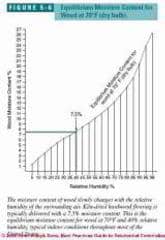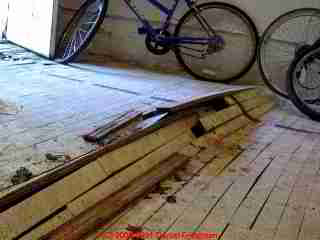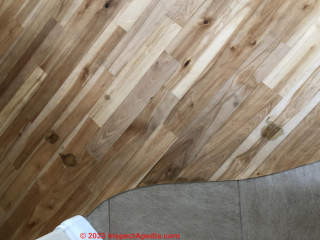 Effects of Moisture on Wood Flooring
Effects of Moisture on Wood Flooring
- POST a QUESTION or COMMENT about moisture problems in building floors or flooring materials
Moisture in wood & wood floors:
This article explains the effects of moisture on wood floors and reviews the proper moisture levels necessary when working with or installing a wood floor.
Moisture Content in Wood Affects Wood Floor Shrinkage, Swelling, Gaps, Finishes. Need for Acclimatization of Wood Flooring Before Installation.
This article series discusses and provides a best construction practices guide to the selection and installation of building interior surface materials, carpeting, doors, drywall, trim, flooring, lighting, plaster, materials, finishes, and sound control materials.
InspectAPedia tolerates no conflicts of interest. We have no relationship with advertisers, products, or services discussed at this website.
- Daniel Friedman, Publisher/Editor/Author - See WHO ARE WE?
Guide to the Effects of Moisture on Wood Flooring: Best Wood Floor Installation Practices
 As described in the book, Best Practices Guide to Residential Construction (Steve Bliss, J Wiley & Sons) Chapter 5, Interior Finish:
As described in the book, Best Practices Guide to Residential Construction (Steve Bliss, J Wiley & Sons) Chapter 5, Interior Finish:
Understanding and controlling moisture levels is the key to success with wood flooring.
The conventional wisdom of acclimating wood flooring to job-site conditions can cause more harm than good if the job site is not sufficiently dry when the flooring arrives.
[Click to enlarge any image]
Wood flooring installed in very dry conditions and later exposed to high moisture levels can cause problems such as cupping, particularly with wider planks.
In extreme cases, the swelling planks crush the wood fibers along their edges, leaving a permanent “compression set.”
Gaps appear when the flooring returns to its normal moisture content.
Moisture Content in Wood Affects Wood Floor Shrinkage, Swelling, Gaps, Finishes
Wood is a hygroscopic material, meaning that it picks up or gives off moisture to the air until it reaches equilibrium with the relative humidity.
While there is wide variation among wood species and among individual boards, Simpson & TenWolde put the shrinkage percent from green to oven-dry moisture content in Coastal Douglas Fir at
1.8% radial,
7.6% tangential, and
12.4% volumetric. - (Simpson 1999 US FPL)
As it absorbs or releases moisture, the wood swells or shrinks (see Figure 5-6).
Finishes and sealers on the wood slow this process, but do not stop it.
Most hardwood flooring is kiln-dried and delivered with a moisture content (MC) of about 7.5%, which is approximately the equilibrium moisture content for wood at 70°F and 40% relative humidity—typical indoor conditions for most of the U.S.
Need for Acclimatization of Wood Flooring Before Installation
 While much has been written about
acclimating wood flooring to the job site before installation,
in most cases it is the job site that should be dried out
before the wood is delivered.
While much has been written about
acclimating wood flooring to the job site before installation,
in most cases it is the job site that should be dried out
before the wood is delivered.
If dry wood flooring is brought onto a wet job site, the flooring will swell as it adjusts, creating unsightly gaps when it shrinks back to normal levels.
Our photo of an exploded wood floor in an old gymnasium (below a roof leak) demonstrates that the effects of excessive moisture on an installed wood floor can be extreme.
Details are
at FLOOR WOOD, DAMAGE DIAGNOSIS. - DF.
Before the flooring is delivered, the building should be closed in, and all concrete, masonry, drywall, paint, and other wet work should be thoroughly dry.
The basement should be dry and the ground sealed in any crawlspaces.
The goal is to have the indoor relative humidity and the moisture content of the subflooring close to the levels they will be after the home is occupied. To sufficiently dry out the site, it may be necessary to run the heating or air conditioning for a week or more prior to delivery of the flooring.
As a rule of thumb, the subflooring moisture content should be no more than 2% over the maximum normal level for that region based on the map in Figure 5-7, and the flooring and subflooring should be within 2 percentage points of each other.
A moisture meter is necessary to determine these levels. Checking the relative humidity with a hygrometer is also a good idea.

With the exception of extremely humid regions such as the Gulf Coast, or extremely dry regions like the arid Southwest, wood delivered at 7.5% moisture content will be suitable for installation in a dry home.
If the flooring needs to be acclimated, unbundle the boards and spread them out in the rooms where they will be installed until they reach a moisture content within the range shown in Figure 5-7 above.
- - Adapted with permission from Best Practices Guide to Residential Construction (Steve Bliss, J Wiley & Sons) .
Wood Floor Moisture Research
- Doggett, Steven M., "Unexpected Expansion of Fiber Cement Panels", [PDF] The Building Exnclosure (website), (14 Feb 2012), retrievedf 12/21/2014, original source: https://builtenv.wordpress.com/2012/02/14/ unexpected-expansion-of-fiber-cement-panels/
- Falemara, B. C., J. M. Owoyemi, and B. Olufemi. PHYSICAL PROPERTIES OF TEN SELECTED INDIGENOUS WOOD SPECIES IN AKURE, ONDO STATE, NIGERIA [PDF] Journal of Sustainable Environmental Management (JSEM) 4 (2012): 16-23.
- Skaar, C., Wood Water RElations, 1988, Springer-Verlag, New York 1988
- Simpson, W.T., ed., "Dry Kiln Opeator's Manual", Agriculture Handbook 188, USDA Forest Service
- Simpson, William, TenWolde, Anton, PHYSICAL PROPERTIES AND MOISTURE RELATIONS OF WOOD [PDF] from U.S. FPL, Forest Products Laboratory, Wood Handbook - Wood as an engineering material", 1999, Gen. Tech. Rep. FPL-GTR-113, Madison WI, U.S. Department of Agriculture (USDA) Forest Service, FPL. - retrieved 2024/02/07 & 12/20/2014, original source: woodweb.com/Resources/wood_eng_handbook/Ch03.pdf
Excerpts:
Wood exchanges moisture with air; the amount and direction of the exchange (gain or loss) depend on the relative humidity and temperature of the air and the current amount of water in the wood. This moisture relationship has an important influence on wood properties and performance. This chapter discusses the physical properties of most interest in the design of wood products.
Moisture content of wood is defined as the weight of water in wood expressed as a fraction, usually a percentage, of the weight of ovendry wood. Weight, shrinkage, strength, and other properties depend upon the moisture content of wood. In trees, moisture content can range from about 30% to more than 200% of the weight of wood substance.
In softwoods, the moisture content of sapwood is usually greater than that of heartwood. In hardwoods, the difference in moisture content between heartwood and sapwood depends on the species.
The average moisture content of heartwood and sapwood of some domestic species is given in Table 3–3.
These values are considered typical, but there is considerable variation within and between trees. Variability of moisture content exists even within individual boards cut from the same tree. - Simpson, W.T., ed., "Dry Kiln Opeator's Manual", Agriculture Handbook 188, USDA Forest Service
- Skaar, C., Wood Water RElations, 1988, Springer-Verlag, New York 1988
- Stamm, A.J., Loughborough W.K., Thermodynamics of the swelling of wood, Journal of Physical Chemistry 1935, 39(1):121
...
Reader Comments, Questions & Answers About The Article Above
Below you will find questions and answers previously posted on this page at its page bottom reader comment box.
Reader Q&A - also see RECOMMENDED ARTICLES & FAQs
On 2020-06-02 by danjoefriedman (mod) - diagnose cause of recurring dark spots on woode flooring
When you replaced the flooring, were there indications of water or other leaks on the surface below?
Tose spots are more or less in the center of boards so I don't think this is somethign seeping up from below. It looks more as if it's coming from deposits onto the floor.
Is this an engineered wood or laminate floor covering or is it conventional thick (say 3/4" thick) wood ton gue and groove boards?
On 2020-05-31 bny Danny
I have had an issue with my floor with black spots about 3 years ago. The floor is about 10 years old. The spots are just in two areas. We have had portions of the floor removed and replaced, but the spots returned about a year latter. The flooring is on a concrete slab. I live close the ocean in Ventura County, Ca. We don’t know what to do.
On 2018-10-20 by danjoefriedman (mod) - why are black spots appearing on my flooring?
No, Diane, though if you attach some photos I may be able to comment further.
From what you've said so far it doesn't sound as if the issue is water below the floor.
On 2018-10-20 by Diane
My apt wood floor (12 years old) is glued to plywood and plywood nailed to cement floor.3-4 inch black spots and markings started to appear. Mostly in exposed areas, very few under rugs. The floor is not cupping and some marks have a silvery tint. Nothing rubs off when wiped. The marks look like burn marks. Any ideas what this is from?
Question: how wet does drywall have to be to require removal -?
Jan 30, 2014) Phil said:
What % of moisture or water penetration into Drywall can it reach before it can not be dried and has to be removed. Also, if there is a time limit on when you have to start the drying process.
Reply:
Phil, that's an interesting question and I haven't thought about wet drywall quite that way. Let's try this:
If drywall is wet above 18% or so, even if just measured on the drywall surface, then conditions are ripe for mold formation; Generally the rate at which mold will grow on wet drywall depends on moisture levels and temperature;
While there are molds that will grow under just about any condition, in buildings drywall mold of any of about 40 common genera/species will show up in 24-48 hours.
Wetter drywall grows different species (such as Stachybotrys chartarum) than less-wet but still too-wet drywall (18% say) (such as Aspergillus sp.).
So I would say that regardless of how wet the drywall is, if we could get it dry - say at 12% or less throughout its thickness - in 24-48 hours and if we don't already see mold growth on it, we're probably OK.
See WET, DEFINITION OF where we describe the critical moisture level for various building materials
and
Also use our on-page search box to earch InspectApedia for
Mold on Walls, Drywall, or "Sheetrock®"
where I will re-post this question and where you will find more detail
Thanks for asking
Question: high utility bills with radiant heat floor
(Dec 12, 2014) Margo said:
I live in a small, single-level slab on grade duplex rental in Superior, WI built in early 2012 with water-based radiant heat as the only heat source and no cooling system. What could be causing the following:
1. Oozing of a substance that looks and feels like wet sand from between the seems of the flooring during warmer months
2. Worms coming from either the seams or the exterior edges of the home in warmer months
3. Warping and cupping at the seams of the flooring, including a couple of spots where a perfect circle can be seen in the flooring (about the size of a baseball)
4. Visible gaps at some seams of the flooring (about 1/8 inch each)
5. Utility bills are about twice as high as one would expect, going over $300/month in winter (around $80 in summer)
Thank you!
Reply:
Margo it sounds to me as if water is leaking under your floor and that there are various infestations that need to be addressed as well, perhaps, as structural damage.
If the leak is in a radiant heat floor that could explain abnormal heating bills.
See inspectapedia.com/Energy/Radiant_Heat_Use.htm
...
Continue reading at FLOOR, WOOD INSTALLATION GUIDE or select a topic from the closely-related articles below, or see the complete ARTICLE INDEX.
Or see these
Recommended Articles
- BUCKLED WOOD FLOORING
- FLOOR, WOOD RADIANT HEAT
- WOOD FLOOR AGE TYPES HISTORY - identify types of wood flooring, density, moisture sensitivity, expansion, etc.
- WOOD FLOOR DAMAGE REPAIR - home
- FLOOR, WOOD INSTALLATION GUIDE
- SIDING FIBER CEMENT COEFFICIENTS of EXPANSION
Suggested citation for this web page
FLOOR, WOOD MOISTURE at InspectApedia.com - online encyclopedia of building & environmental inspection, testing, diagnosis, repair, & problem prevention advice.
Or see this
INDEX to RELATED ARTICLES: ARTICLE INDEX to BUILDING FLOORING
Or use the SEARCH BOX found below to Ask a Question or Search InspectApedia
Or see
INDEX to RELATED ARTICLES: ARTICLE INDEX to BUILDING INTERIORS
Or use the SEARCH BOX found below to Ask a Question or Search InspectApedia
Ask a Question or Search InspectApedia
Try the search box just below, or if you prefer, post a question or comment in the Comments box below and we will respond promptly.
Search the InspectApedia website
Note: appearance of your Comment below may be delayed: if your comment contains an image, photograph, web link, or text that looks to the software as if it might be a web link, your posting will appear after it has been approved by a moderator. Apologies for the delay.
Only one image can be added per comment but you can post as many comments, and therefore images, as you like.
You will not receive a notification when a response to your question has been posted.
Please bookmark this page to make it easy for you to check back for our response.
IF above you see "Comment Form is loading comments..." then COMMENT BOX - countable.ca / bawkbox.com IS NOT WORKING.
In any case you are welcome to send an email directly to us at InspectApedia.com at editor@inspectApedia.com
We'll reply to you directly. Please help us help you by noting, in your email, the URL of the InspectApedia page where you wanted to comment.
Citations & References
In addition to any citations in the article above, a full list is available on request.
- Steve Bliss's Building Advisor at buildingadvisor.com helps homeowners & contractors plan & complete successful building & remodeling projects: buying land, site work, building design, cost estimating, materials & components, & project management through complete construction. Email: info@buildingadvisor.com
Steven Bliss served as editorial director and co-publisher of The Journal of Light Construction for 16 years and previously as building technology editor for Progressive Builder and Solar Age magazines. He worked in the building trades as a carpenter and design/build contractor for more than ten years and holds a masters degree from the Harvard Graduate School of Education. Excerpts from his recent book, Best Practices Guide to Residential Construction, Wiley (November 18, 2005) ISBN-10: 0471648361, ISBN-13: 978-0471648369, appear throughout this website, with permission and courtesy of Wiley & Sons. Best Practices Guide is available from the publisher, J. Wiley & Sons, and also at Amazon.com - 1996 Ashrae Handbook Heating, Ventilating, and Air-Conditioning Systems and Equipment: Inch-Pound Edition (Hardcover), ISBN-10: 1883413346 or ISBN-13: 978-1883413347 ,
"The 1996 HVAC Systems and Equipment Handbook is the result of ASHRAE's continuing effort to update, expand and reorganize the Handbook Series. Over a third of the book has been revised and augmented with new chapters on hydronic heating and cooling systems design; fans; unit ventilator; unit heaters; and makeup air units. Extensive changes have been added to chapters on panel heating and cooling; cogeneration systems and engine and turbine drives; applied heat pump and heat recovery systems; humidifiers; desiccant dehumidification and pressure drying equipment, air-heating coils; chimney, gas vent, fireplace systems; cooling towers; centrifugal pumps; and air-to-air energy recovery. Separate I-P and SI editions." - In addition to citations & references found in this article, see the research citations given at the end of the related articles found at our suggested
CONTINUE READING or RECOMMENDED ARTICLES.
- Carson, Dunlop & Associates Ltd., 120 Carlton Street Suite 407, Toronto ON M5A 4K2. Tel: (416) 964-9415 1-800-268-7070 Email: info@carsondunlop.com. Alan Carson is a past president of ASHI, the American Society of Home Inspectors.
Thanks to Alan Carson and Bob Dunlop, for permission for InspectAPedia to use text excerpts from The HOME REFERENCE BOOK - the Encyclopedia of Homes and to use illustrations from The ILLUSTRATED HOME .
Carson Dunlop Associates provides extensive home inspection education and report writing material. In gratitude we provide links to tsome Carson Dunlop Associates products and services.


